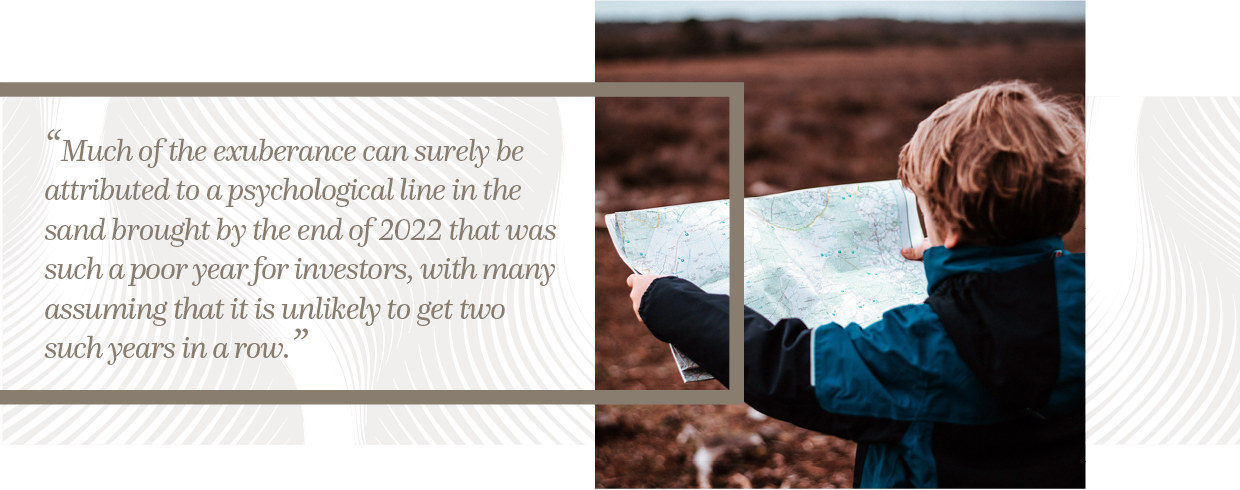Monthly Investment Outlook – February 2023
Market Overview
Risk assets are enjoying a strong start to 2023, lifted by optimism that the Federal Reserve is preparing to scale back its rate-tightening campaign and that the corporate earnings season will reveal better results than widely anticipated, while the reopening of the Chinese economy has especially benefitted European stocks. This, however, is a rally built on a number of contradictions, not least that global economic data points to a global recession and both the Fed and the ECB have been at pains to insist that they are sticking to their established rate targets. Much of the exuberance can surely be attributed to a psychological line in the sand brought by the end of 2022 that was such a poor year for investors, with many assuming that it is unlikely to get two such years in a row.
With some markets already 10% in the green before the end of January, the same mentality may see a bout of profit taking, as many money-managers would be delighted at the prospect of such a return for the whole of 2023, let alone one month! Currently it would appear that equities are expecting a mild recession, while the bond markets (Treasuries) are pricing in something deeper, looking at the major yield curves. We are aware that there is still a mismatch between the Federal Reserves’ projected rate peak (of around 5.2%) , and the bond markets predictions of 4.9%.
A further contradiction is the current and ongoing outperformance of European stocks compared with their US counterparts, as while the argument that they are merely closing the gap after years of trailing returns can be made, inflation remains far higher in Europe with the central bank ostensibly needing to hike more aggressively at this juncture. While the reappearance of China economically is indeed bullish for European exporters, and a mild winter is negating some of the higher energy costs for the region, it is nevertheless more exposed to the Ukraine conflict and earnings estimates for European companies still seem stretched versus the US. While we are happy to participate in the new year rally, we are not entirely comfortable with these contradictions and the tenuous market narrative, so maintain a cautious approach until events justify otherwise.

Equities |
Bonds |
Other |
|---|---|---|
| The current rally is welcome, but unconvincing. We expect more volatility before seeing the genuine start of the next cycle. | Bonds once again look capable of fulfilling our main criteria of capital preservation and meaningful income, but a selective approach is needed. | Liquid UCITS alternative funds are a crucial diversifier as traditional asset correlations have broken down. Gold and Silver look well set. |
Interest rate
Central Bank Rates:
| Country | Current rate | 3 Months | 6 Months | 9 Months | Peak |
|---|---|---|---|---|---|
| US | 4.33 | 4.795 ↑ | 4.909 ↑ | 4.751 ↓ | 4.909 (June) |
| EU | 1.904 | 2.834 ↑ | 3.277 ↑ | 3.338 ↑ | 3.338 (September) |
| UK | 3.43 | 4.164 ↑ | 4.359 ↑ | 4.348 ↓ | 4.379 (August) |
| Japan | -0.01 | 0 ↑ | 0.074 ↑ | 0.133 | 0.199 (December) |
Our sub-asset class views
| – | = | + | ||||||
|---|---|---|---|---|---|---|---|---|
| EQUITIES | The new year rally may well turn out to be a false dawn with more central bank tightening to come. Earnings estimates in general look overoptimistic and markets are not priced for recession yet. | |||||||
| US | Equities are being directed by rate expectations at the moment, and while the US economy looks better placed than elsewhere, its’ growth bias makes it vulnerable to earnings revisions. | |||||||
| UK | British stocks are still very cheap compared with other markets, and the energy/mining component of the 100 is attractive. Bleak political/economic backdrop. | |||||||
| Eurozone | Region is grappling with high inflation and energy prices but this has been offset by the China reopening and a mild winter. Energy and financial stocks look the best value. | |||||||
| Switzerland | Quality, defensive nature of the market continues to see Swiss stocks in demand, though valuations relatively rich now. | |||||||
| EM | We retain an allocation to emerging Asia for the long-term growth potential, with China’s reopening finally here. Most EM regions do not justify their risk premiums. | |||||||
| Japan | Attractive valuation for a developed market, with a lower yen supporting its export sector. Economy currently slowly ‘reopening’ from Covid. | |||||||
| FIXED INCOME | Yields are far more attractive than a year ago, but it is unclear whether a period of structurally higher rates and inflation is yet priced in. We will look to add selectively. | |||||||
| Sovereign Bonds | US yield curve is inverted and rates remain under threat while inflation remains elevated. Recession may see some support, but not until FED expectations peak. | |||||||
| Corporate I.Grade Bonds | Buyers may soon come back with 5% yields for corporates looking attractive against a recessionary backdrop. US looks preferable to Europe. | |||||||
| High Yield Bonds | Default rates are subdued, but may rise as financing costs increase. Yields look attractive, but highly selective approach needed. | |||||||
| E.M. Bonds | We are generally cautious on emerging markets given looming recession fears, but our short duration approach achieves yield at acceptable risk. | |||||||
| ALTERNATIVES | We like holdings that are genuinely uncorrelated to the main asset classes. | |||||||
| Precious Metals | Gold may get a boost as rate expectations peak. Remains the most compelling long-term hedge against inflation and elevated geopolitical risk. | |||||||
| Hedge Funds | Genuine alternative funds that behave in a different manner to traditional assets are a vital source of wealth preservation and diversification. | |||||||
| Oil/Commods | Commodities mania has subsided, but shifting geopolitics and green policies will offer structural upside over the longer term. |
| – | = | + | ||||||
|---|---|---|---|---|---|---|---|---|
| CURRENCIES | DXY strength has finally subsided with expectations of a Fed slowdown, but we would not be surprised by a short term recovery in the first half of the year. Risk currencies and EM FX could do well over the longer term. | |||||||
| U.S. Dollar (DXY) | The dollar is only likely to retreat further if lower inflation trend is confirmed and FED becomes more dovish. Likely to be underpinned by relative resilience of US economy v Europe. | |||||||
| Sterling (GBP) | GBP has recovered more due to USD weakness than any great optimism over the UK’s economic prospects. Whether the BOE close the gap on the Fed will determine mid term outlook. | |||||||
| Euro (EUR) | Has rallied on USD weakness and following 0.75% ECB hike. Economy looks turgid, and ECB will be wary of hiking too hard in face of recession. | |||||||
| Japanese Yen (JPY) | JPY weakness has been the ccy story of 2022 and looks overdone. Policy remains loose, but economy improving and BOJ have informally stepped in at 150 level. | |||||||
| Swiss Franc (CHF) | CHF remains relatively steady, as SNB underwhelmed with 0.75% hike. Swiss inflation much less than EUR and GBP. | |||||||
| EM | CNY will benefit from economic pick-up in China, while other EM’s will enjoy carry from and long term USD weakness. |

